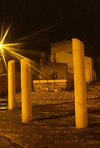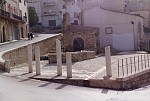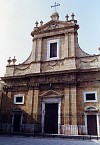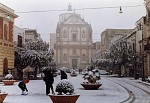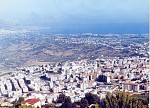| |
|
| | >>
Alcamo
|
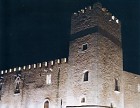 |
| Alcamo
: Comune della provincia di Trapani di 47.000 abitanti circa |
| Come Raggiungerla
: da Alcamo Marina percorrere fino all fine la strada comunele che portala
all'autostrada A29 | | Sito
Ufficiale : www.comune.alcamo.tp.it |
| | | Rich
of monuments and works, Alcamo rises in front of the gulf of Castellammare, among
the hills covered by vineyards which extend from the feet of Monte Bonifato to
the sea. Native land of Cielo D'Alcamo (author of the "Contrasto d'Amore",
the first written literary work in vulgar Italian), Alcamo was born during the
Arabic domination as Manzil Al Qamah, a country house-station along the commercial
road that joined Palermo to Mazara del Vallo, protected by the two fortresses
of Bonifato and Calatubo described, in the XII century, by the arab geographer
Al Idris and by the andalusian pilgrim Ibn Gubayr. | | In
the XIV century, under the domination of the Ventimiglia family, with the construction
of the castle "of Conti di Modica", after the definitive abandonment
of the inhabited centre on Mount Bonifato, protected by walls, the first big inhabited
nucleus developes. From the XV to the XVIII century at the borders of the city,
there is the settlement of the religious orders around which, outside the 14th
century city-walls, the new quarters were born. At the end of the XVII century,
with the building of the imposing church of Jesus, the "Piano Maggiore"
(the present Piazza Ciullo), hinge between the original nucleus and the "new
city", becomes the fulcrum of the baroque of Alcamo and assumes, already
from that time, the function of city centre. | | After
the union of Italy, with the transformation of the buildings belonged to the religious
orders into schools, hospitals and barracks, and with the destruction of its walls,
the building expansion until the slopes of Mount Bonifato begins and, at the same
time, there is the progressive decline of the ancient part of the city. In the
last years, with the consolidation and the restoration of the main monuments,
made with the rediscovery of the architectonic heritage, the historical center
assumes again the function of city "living-room". | | The
visit can begin from the public square, Piazza Ciullo. At the corner with the
"cassaro grande" (Corso 6 Aprile), rises the church of S. Oliva. It
has been built up between 1722 and 1774 by the architect Giovan Biagio Amico on
a previous 14th century church. The outside is simple but imposing, with a high
facade enriched by a 16th century portal and a small angular bell tower without
external cuspid in the apse. With the restorations carried out after the fire
of 1989, in which the ceiling frescoes have been destroyed, the church, in its
lonly nave, is rich of putties, paintings and polychrome marbles. Among the works,
we remind the "Anime Sante del Purgatorio" (1639), valuable painting
of Pietro Novelli, unfortunately badly restored, situated on the main altar; the
statue of S. Oliva (1511), one of the masterpieces of Antonello Gagini; two marble
panels belonging to the Gagini school, at the sides of the apse, representing
S. Luca and S. Angelo (XVI century), and the marble group of the "Annunciazione",
coming from the church of "L'Annunziata" and made by Antonino and Giacomo
Gagini (1545), which we find in the first chapel on the left. The square is dominated
by the church of "collegio Gesuiti" (1684-1767), with the high and harmonious
facade decorated of sculptures and friezes, and surmounted, at the sides, by two
small twin bell towers. | | The
inside, with its lonly nave with transept, keeps some paintings of Novelli's school
(XVIII century), S. Francesco Saverio and S. Ignazio di Lojola and, on the main
altar, The Circoncisione (the Circumcision), great painting realized in 1796 by
the painter Giuseppe Renda and ordered by the Jesuits. In the near oratory, unfortunately
badly preserved, the frescoes of Domenico La Bruna are visible. They represent
the "Assunta" and the "Santi Gesuiti" (1738). Walking along
Via Mazzini, we arrive in Piazza della Repubblica, at the 14th century Castle
of the "Conti di Modica". Often rehashed, the building keeps at present
the original structure with rhomboidal plant, with four towers on the corners
(two square and two round), and the elegant windows of gothic-catalan taste. Beyond
the public square, on Piano S. Maria, is the church of S. Maria del Gesù
founded in the XV century, with the annexed convent of the Minor Friars, by the
Blessed Arcangelo Plagenza, coming from Calatafimi. Widened in 1507, as the Counts
of Modica wished, and restructured in 1762, it is characteri-zed, in the facade,
by a singular portal with arches and four columns in white marble, enriched by
corinthian capitals. In the inside, after the elegant portal ascribed to Berrettaro
(1507), we find a valuable marble case of Baldassare Massa (1556). Above the glass
urn, which keeps the Blessed Archangel's corpse, founder of the church, you can
admire the splendid table of the "Madonna Greca" (XVI century). |
| Raffigura la Madonna col Bambino
tra i Santi Francesco e Benedetto e, inginocchiati con alcuni cavalieri e dame,
i conti di Modica Federico Enriquez d'Aragona e Anna I Cabrera, ricostruttori
della chiesa. Notevoli sono pure la statua della Madonna col Bambino (sec. XVI)
posta all'altare maggiore, attribuita al Berrettaro o al Mancino, e gli affreschi
delle pareti raffiguranti le Stazioni della Via Crucis, eseguiti nel 1901 da Carlo
Righetti. Tornati in piazza Ciullo, immettendoci nel "cassaro stretto"
nel punto in cui nelle antiche mura si apriva la Porta Trapani, si entra nella
"città vecchia". Nella piazzetta IV novembre prospetta la chiesa
Madre, dedicata a S. Maria Assunta ed elevata a Basilica nel 1966. Fondata nel
1332 e ampliata nel XVI secolo, deve l'attuale aspetto agli architetti Angelo
Italia e Giuseppe Diamante (1669). La facciata, disegnata da Emanuele Cardona,
risale al 1785. Dell'edificio originario conserva il campanile, realizzato adattando
una preesistente torre di avvistamento, il portale del lato est, attribuito al
Berrettaro (1499), e l'elegante Cappella dello Spirito Santo o della Sacra Spina
(1430), che si apre in fondo alla navata destra. Conserva gli archi originali
ad ogiva in pietra e l'affresco de "La Pentecoste" (sec. XV) scoperto
durante i restauri del 1958. All'altare è posto un prezioso reliquiario
del 1636 in cui è racchiusa una spina appartenuta, si dice, alla corona
di Cristo. | | The painting
is of uncertain author but it can be attributed to Antonello Crescenzio, to whose
style it seems to be near, for the influences of the Lombardic art, which are
visible in the painting. He represents the Madonna with the Child between the
Saints Francis and Benedict and, knelt down with some knights and ladies, the
counts of Modica Federico Enriquez D'Aragona and Anna I Cabrera, who rebuilt the
church. Remarkable are even the statue of the "Madonna col Bambino"
(XVI century) on the main altar, attributed to Berrettaro or Mancino, and the
frescoes of the walls representing the "Stazioni della Via Crucis"(the
Via Crucis stops), realized in 1901 by Carlo Righetti. | | Back
to Piazza Ciullo, entering the "cassaro stretto", where in the ancient
walls "Porta Trapani" opened, we get into the "old city".
In "IV November Square", there is the Mother Church, dedicated to S.
Maria Assunta and nominated "Basilica" in 1966. It was founded in 1332
and widened in the XVI century. Its present aspect is due to the architects Angelo
Italia and Giuseppe Diamante (1669). The facade, designed by Emanuele Cardona,
goes back to 1785. The bell tower realized adapting a preexisting military tower,
belongs to the original building. Of the same period are the portal of the east
side, attributed to Berrettaro (1499), and the elegant "Cappella dello Spirito
Santo e della Sacra Spina" (Chapel of the Holy Spirit and of the Sacred Thorn)
(1430), at the end of the right aisle. It keeps original stone pointed arches
and the fresco of "La Pentecoste" (The Witsunday) (XV century) discovered
during the restorations of 1958. | | At
the altar is placed a precious reliquary of 1636, in which there is a thorn, that,
as they say, belonged to the crown of Jesus Christ. The inside of the church has
got a basilica plan, three naves divided by two rows of red marble monolithic
columns, coming from the Mount Bonifato. It keeps frescoes, realized in 1736-37
by the flemish painter William Borremans, and many other works of remarkable historical
and artistic interest. Among them there are, in the right nave, a "Crocifisso"
(Crucifix) in mixture (1523), a marble case (1519) of Antonello Gagini, and "L'Ultima
Cena" (Last Supper) (1613), a painting of Andrea Carrera on the right chapel
of the main altar. Admiring are even "L'Assunta" (1605), great painting
of Neapolitan school on the main altar, the statue of St. Peter (1586), realized
by Giacomo Gagini, on the altar of the tranpset, the "Madonna della Neve"
(Our Lady of the Snow), fresco of the end of the XIV century, placed in the chapel
on the left side of the main altar and, on the altar of the same chapel, the statue
of the "Madonna dei Miracoli" (Our Lady of the Miracles) of Lorenzo
Curti (1720) author, with his sons, of some stuccoes of the same church. Very
beautiful is also the XVI century portal which lets in the sacristy, attributed
to Berrettaro | | One of
the most valuable works of the church and, probably, of all Alcamo,is the high-relief
of the "Transito della Vergine", in the third chapel of the left aisle.
Realised in 1529 by Antonello Gagini, it represents, in a very expressive scene,
the Virgin Mary on the death-bed encircled by the twelve Apostles. In the near
chapel, at the sides of the wooden statue of the "Madonna del Carmelo"
(at the end of the XVII century), we find two oval paintings of Borremans representing
two episodes of the Old Testament: Abigail taming David's rage and Rutz and Booz.
In this painting, according to tradition, the author has represented himself in
the figure of Rutz, and one of his daughters in the one of Booz. Going on towards
the exit door, in the first chapel of the left aisle, near the marble christening
font of the beginning of the 16th century, there is the painting "Madonna
del Lume" of Giuseppe Renda (XVIII century). | |
| | il
testo è stato redatto da Giuseppe Calandrino | |
|
|


